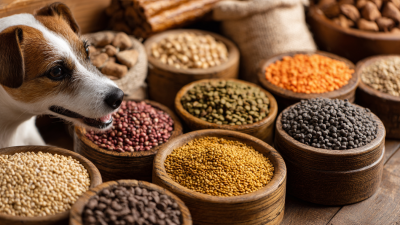Getting a handle on how pet food prices work can really make a difference for pet parents trying to make the right choices for their furry friends’ nutrition. As one of China’s top pet food makers, Shandong Luscious Pet Food Co., Ltd. gets that transparency and quality matter — big time. We offer a pretty wide variety of products, from dog food and cat food to chicken jerky, all designed to help you sort through the sometimes overwhelming world of pet food prices. In this guide, we’ll break down the main factors that affect how much pet food costs — stuff like ingredient quality, manufacturing process, and more — so you can feel confident you're picking the best for your pets without sacrificing their health or happiness. Join us as we take a closer look at what influences these prices, so you can make smarter, more informed decisions when it comes to caring for your furry buddies.

figuring out how pet food prices relate to ingredient quality is pretty important if you're trying to make smart choices for your furry friend. I read a report from the Association of American Feed Control Officials (AAFCO) back in 2022, and it pointed out that those pricier dog foods usually pack in better proteins, whole grains, and fresh fruits and veggies. That makes sense, right? Good-quality ingredients cost more to source, so naturally, the price goes up. If you see dog food costing $3 or more per pound, chances are, meat is one of the main ingredients — which is a good sign of solid nutrition overall.
On the other hand, some cheaper brands might catch your eye because they’re easier on the wallet. But beware — they often include fillers and artificial stuff that might not do your pup any favors over time. Many studies show that spending a little extra on higher-quality foods can actually pay off: fewer trips to the vet, more energetic days, and better overall health for your dog. So, knowing how these prices work can really help you pick a food that balances your budget while still giving your pet the nutrition they need.

When you're looking at pet food prices, it's pretty clear that a brand's reputation really matters. Brands that have built a solid track record for quality—like sourcing ingredients responsibly and keeping safety standards high—tend to charge more. Pet owners are often willing to pay a bit extra for products from reputable brands, mostly because they believe these options offer better nutrition and are healthier for their pets. And honestly, that trust doesn’t happen overnight; it’s built over time through consistent quality and transparency about where ingredients come from. In the end, it justifies the higher price tag.
Plus, in such a crowded pet food market, a strong brand reputation actually helps a lot in standing out. Companies that push their values through marketing and PR—like participating in community projects or supporting animal welfare—don’t just get more visibility, they also earn more loyalty from pet owners. People tend to feel more connected to brands that share their values, and that emotional connection often makes them okay with paying a premium for products that align with what they believe in. So yeah, understanding how important reputation is really helps pet parents make better choices, especially since it influences both quality and price of the food they pick for their furry friends.
| Price Range ($) | Average Quality Score | Brand Reputation Score (out of 10) | Nutritional Value (out of 100) | Customer Satisfaction Rate (%) |
|---|---|---|---|---|
| 10 - 25 | 60 | 5 | 70 | 75 |
| 26 - 50 | 75 | 7 | 85 | 80 |
| 51 - 100 | 90 | 8.5 | 90 | 85 |
| 101 - 150 | 95 | 9.5 | 95 | 90 |
| 151+ | 98 | 10 | 98 | 95 |
When you're shopping for pet food, you quickly notice that prices can vary a lot between store brands and the more premium options. Usually, the stuff from the supermarket is promoted as a budget-friendly pick—perfect if you're trying to save a few bucks. But if you take a closer look, you might realize that those cheaper brands don't always pack the best nutrition or use top-quality ingredients. Over time, that could actually affect your pet’s health, which is something worth thinking about. It’s important for pet owners to keep this in mind when deciding what to buy.
On the flip side, premium brands—like those from Shandong Luscious Pet Food Co., Ltd.—tend to cost more, and that's mainly because they focus on using better ingredients and creating well-balanced formulas. Their dog and cat foods often feature wholesome, high-quality stuff, aimed at folks who really want to prioritize their pet’s health. Investing in these higher-quality options might mean fewer visits to the vet and overall less medical expenses down the road. As more pet owners learn about the real differences in pet food quality and price, many find that quality is worth the extra bucks—that it pays off in the long run.

When it comes to pet food, price regulation really plays a big part in making sure everything's fair and that customers are protected. Knowing how these rules influence prices can actually help pet owners make smarter choices. Regulatory agencies keep an eye on how pet food is made and labeled to make sure it meets safety and nutritional standards—that’s partly why some brands charge more. Usually, the premium brands have higher prices because they use better ingredients and do more thorough testing, which adds to the cost.
If you're shopping for pet food, here are a few tips to keep in mind. First off, always glance at the ingredients list. Just because something’s pricey doesn’t necessarily mean it’s better quality—sometimes it’s just the brand name pushing the price up. Secondly, look for certifications from reputable organizations; those can be a good sign that the product meets certain quality standards. And finally, considering buying in bulk can be a real money-saver—buying bigger packs often lowers the cost per unit and ensures you’ve got enough on hand for your furry friend. Keeping these things in mind can make navigating the whole pet food pricing thing a lot easier and less stressful.
This chart illustrates the average price of various types of pet food in USD. Understanding these prices can help pet owners make informed decisions about their purchases.
You know, when it comes to pet food, marketing really plays a huge role in how prices are set. It’s like, some brands just know how to make us think we’re getting something special, and so we end up paying a lot more for them. A lot of companies throw tons of money into advertising, snazzy packaging, and cool promos just to make their brand stand out and click with pet owners. This clever branding makes us see their products as higher quality—even if, honestly, the actual formula isn’t that different from cheaper options. It’s crazy how much that can influence what we’re willing to pay.
Plus, brands often rely on endorsements from vets or heartfelt reviews from pet owners to sway our decisions. They’ve also become really good at using social media and teaming up with influencers—people we trust and follow—so they can tap into our emotional side, especially since many of us see our pets like family. This multi-pronged approach not only keeps us engaged but also bumps up the prices because brands want to be seen as the absolute best.
Honestly, knowing how much marketing affects pet food costs kind of helps us take a step back and ask—are we really getting good value for what we’re spending? It’s good to keep that in mind next time you’re shopping for pet food.
When it comes to pet food prices, packaging honestly doesn’t get nearly enough credit. I mean, those bright colors and eye-catching designs really do make a difference—they catch your eye and can even tug at your emotions a bit. It's not just about how it looks; good packaging also tells you a lot about what's inside—like quality and ingredients—without saying a word. Because of this, brands pour quite a bit into making their packaging stand out from the crowd, and that, of course, ends up influencing the price.
On top of that, the materials used can bump up the cost too. For example, eco-friendly packaging might cost more to produce and design, which can make the final price higher. And features like resealable bags or special freshness tech? Those add convenience and value, so they justify a little extra charge.
All of this stuff helps us understand that when we’re paying for pet food, we’re also paying for the packaging—something that’s meant to keep things fresh, easy to use, and better for the environment. It’s all part of the package, literally!
Air drying has emerged as a transformative method for creating high-quality pet food, particularly for dog owners seeking nutritious options. LSNP-03 beef dice dog food by Luscious exemplifies this trend, showcasing substantial benefits for canine health. With a crude protein content of over 24%, this product meets the nutritional needs of active dogs, supporting muscle maintenance and overall wellbeing. Reports from the Association of American Feed Control Officials (AAFCO) emphasize that high protein diets can contribute to improved body condition and energy levels in pets, making LSNP-03 a compelling choice for discerning pet owners.
Moreover, the air-drying process preserves essential nutrients without the need for artificial preservatives, offering pet owners a wholesome option. The moisture content of under 18% ensures that the product remains shelf-stable for up to 18 months, promoting convenience and reducing waste for retailers. According to a recent market analysis from Market Research Future, pet owners are increasingly inclined towards high-quality, nutrient-dense foods, indicating a growing demand for products like Luscious’s beef dice. With low crude fiber and fat levels, this dog food is especially beneficial for dogs with specific dietary requirements, allowing owners to provide tailored nutrition while ensuring palatability.
As pet ownership trends continue to evolve, investing in premium dog food like LSNP-03 not only enhances the diet of pets but also aligns perfectly with the increasing consumer preference for transparency and quality in pet nutrition. By selecting products that prioritize ingredient integrity, such as beef and its by-products, pet owners can foster a healthier, happier life for their furry companions.
: Brand reputation significantly influences consumer perceptions and preferences, often leading to higher prices for brands known for quality, ethical sourcing, and safety standards.
Pet owners believe that reputable brands provide superior nutrition and health benefits for their pets, which justifies the higher price.
Brands that actively market their values and participate in community initiatives can enhance visibility and strengthen consumer loyalty, leading to acceptance of premium prices.
Price regulation ensures fair practices and consumer protection, influencing pet food pricing by monitoring production and labeling compliance with safety and nutritional standards.
Pet owners should always check the ingredient label, as a higher price does not guarantee better quality; sometimes it reflects branding rather than nutritional value.
Products certified by recognized organizations may indicate quality assurance and can justify higher prices due to their commitment to safety and nutritional standards.
Bulk purchasing options can often reduce the per-unit cost while ensuring a steady supply of pet food, making it a cost-effective strategy for pet owners.
Owners should consider ingredient quality, brand reputation, certifications, and purchasing options to make informed choices about pet food.
Yes, brands that contribute to animal welfare and engage in community initiatives can resonate more with pet owners, fostering a deeper emotional connection and justifying higher prices.
Transparency helps build trust in a brand, leading consumers to feel more comfortable paying a premium for products that are perceived to be of higher quality and safety.
In our 'Ultimate Guide to Understanding Pet Food Pricing: What You Really Need to Know,' we get into the nitty-gritty of what actually influences food prices for our pets. It’s not just about throwing a number on the bag — a lot depends on the quality of ingredients and how a brand’s reputation affects those prices. We also compare supermarket pet foods to the fancy, high-end brands, showing how things like where ingredients come from and how the food is made can really bump up the cost. Plus, we touch on how regulations and marketing tactics play a big role in what you pay at the store.
We even look at packaging — believe it or not, those eye-catching designs can sway your buying choices! Being a major player in China’s pet food scene, Shandong Luscious Pet Food Co., Ltd. is all about transparency and top-notch quality, whether it’s dog and cat food or their popular chicken jerky. Our goal is to help pet owners understand what’s behind the price tag, so you can make smarter choices for your furry friends.













